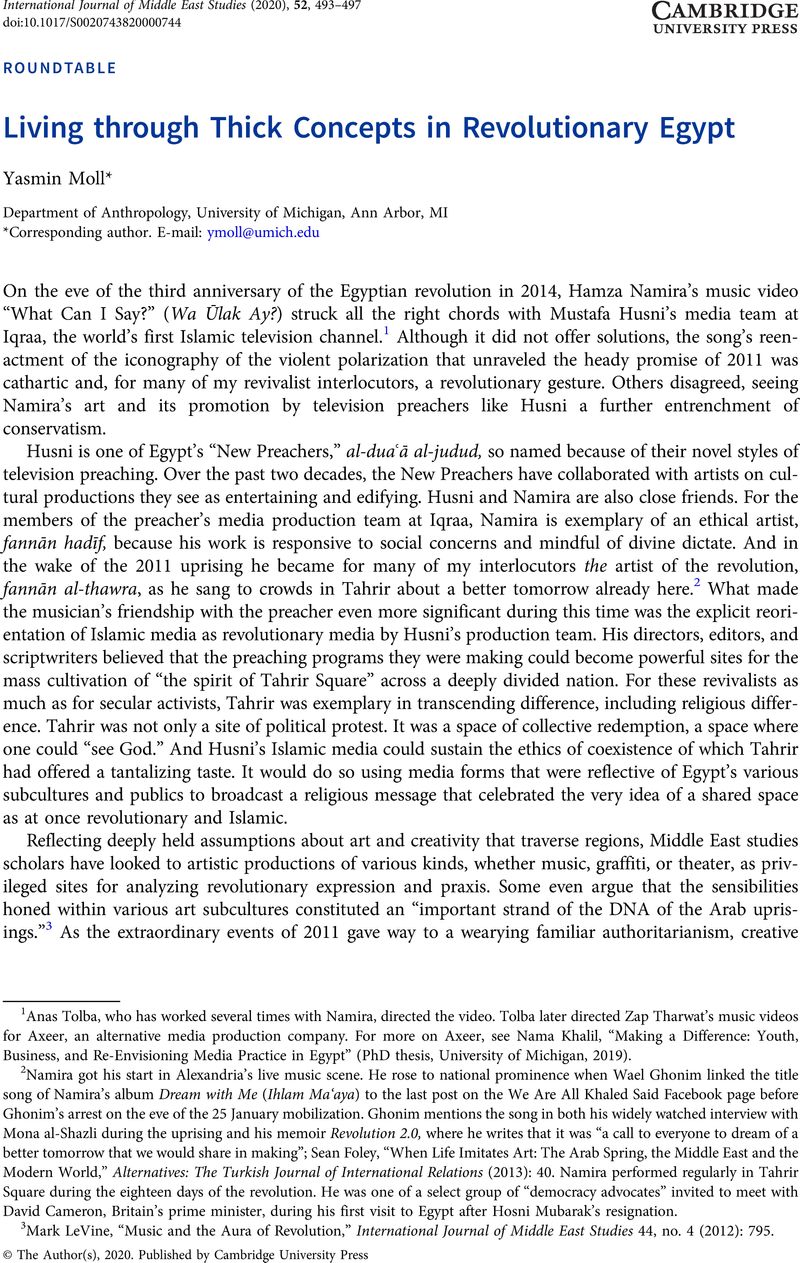Published online by Cambridge University Press: 07 September 2020

1 Anas Tolba, who has worked several times with Namira, directed the video. Tolba later directed Zap Tharwat's music videos for Axeer, an alternative media production company. For more on Axeer, see Nama Khalil, “Making a Difference: Youth, Business, and Re-Envisioning Media Practice in Egypt” (PhD thesis, University of Michigan, 2019).
2 Namira got his start in Alexandria's live music scene. He rose to national prominence when Wael Ghonim linked the title song of Namira's album Dream with Me (Ihlam Ma‘aya) to the last post on the We Are All Khaled Said Facebook page before Ghonim's arrest on the eve of the 25 January mobilization. Ghonim mentions the song in both his widely watched interview with Mona al-Shazli during the uprising and his memoir Revolution 2.0, where he writes that it was “a call to everyone to dream of a better tomorrow that we would share in making”; Sean Foley, “When Life Imitates Art: The Arab Spring, the Middle East and the Modern World,” Alternatives: The Turkish Journal of International Relations (2013): 40. Namira performed regularly in Tahrir Square during the eighteen days of the revolution. He was one of a select group of “democracy advocates” invited to meet with David Cameron, Britain's prime minister, during his first visit to Egypt after Hosni Mubarak's resignation.
3 LeVine, Mark, “Music and the Aura of Revolution,” International Journal of Middle East Studies 44, no. 4 (2012): 795CrossRefGoogle Scholar.
4 The Egyptian artist in exile Ramy Essam characterizes art as part of the solution for youth “vulnerable to a variety of political, criminal and religious agendas.” He goes on, “Artists are their only hope—culture the only tool that can show them the way. It's so hard to demonstrate now in public, but we can still sing”; Hadani Ditmar, “Egypt's Rock Rebel Ramy Essam: ‘My cause is humanity and freedom,’” Middle East Eye, 28 July 2017, https://www.middleeasteye.net/features/egypts-rock-rebel-ramy-essam-my-cause-humanity-and-freedom. The privileging of the aesthetic as salutary is pervasive in Egypt across religious-secular lines; for critical discussions see Winegar, Jessica, “A Civilized Revolution: Aesthetics and Political Action in Egypt,” American Ethnologist 43, no. 4 (2016): 609–22CrossRefGoogle Scholar, and Winegar, Jessica, “Civilizing Muslim Youth: Egyptian State Culture Programs and Islamic Television Preachers,” Journal of the Royal Anthropological Institute 23, no. 4 (2014): 445–65CrossRefGoogle Scholar.
5 Andeel, “Hamza Namira's Conservative Revolution.” Mada Masr, 17 December 2014, https://madamasr.com/en/2014/12/17/feature/culture/hamza-namiras-conservative-revolution/.
6 Bayet, Asef, “Islamism and the Politics of Fun,” Public Culture 19, no. 3 (2007): 433–59CrossRefGoogle Scholar. Other scholars see the “Islamic trend” in Egypt in a primarily censorious relationship with creative expression; its participants “try to constrain and contaminate the intrinsic values of the cultural field by imposing dominant conservative religious ones on the secular players”; Mehrez, Samia, Egypt's Culture Wars: Politics and Practice (London: Routledge, 2008), 7CrossRefGoogle Scholar.
7 For recent contributions, see van Nieuwkerk, Karin, LeVine, Mark, and Stokes, Martin, eds., Islam and Popular Culture (Austin, TX: University of Texas Press, 2016)Google Scholar.
8 The moral philosopher Bernard Williams coined the phrase “thick concept.” He was reportedly inspired by Geertz's “thick description,” which Geertz himself took from the language philosopher Gilbert Ryle; Geertz, Clifford, The Interpretation of Cultures: Selected Essays (New York: Basic Books, 1973), 3–30Google Scholar. For an introduction to thick concepts in moral philosophy, see Pekka Väyrynen, “Thick Ethical Concepts,” in Stanford Encyclopedia of Philosophy, ed. Edward N. Zalta, summer 2019 ed., https://plato.stanford.edu/archives/sum2019/entries/thick-ethical-concepts.
9 Although often considered by academic and social observers alike as particular to Egypt's current political economy, attempts at a specifically Islamic praxis of entertainment and the religious and secular critiques these invariably provoke have a long and rich history. See, for example, Abdelfattah, Heba Arafa, “The Maslaha of Film Production in Pre-Revolutionary Egypt, 1896–1952: A Sanctioning Apparatus or Covert Censorship?” Journal of Islamic and Muslim Studies 2, no. 2 (2017): 1–37CrossRefGoogle Scholar.
10 For excellent exceptions, see Ghannam, Farha, “Meanings and Feelings: Local Interpretations of the Use of Violence in the Egyptian Revolution,” American Ethnologist 39, no. 1 (2012): 32–36CrossRefGoogle Scholar; Rennick, Sarah Anne, “Contested Meanings in the Egyptian Revolution.” Socio 2 (2013): 121–34Google Scholar; and Peterson, Mark Allen, “Re-Envisioning Tahrir: The Changing Meanings of Tahrir Square in Egypt's Ongoing Revolution,” in Revolutionary Egypt: Connecting Domestic and International Struggles, ed. el-Fadl, Reem Abou (London: Routledge, 2015): 64–82Google Scholar.
11 “Al-Idha‘a al-Misriyya Tamna‘ Baththa Aghani Hamza Namira li-l-Intiqadihi al-Nizam,” BBC News Arabic, 20 November 2014.
12 Although conventionally associated with conservative religious movements, the reform of individual ethical conduct is of fundamental concern for many secular leftists as well. Programmatic reflections on the ethics of a socialist society and promotion of socialist habits in individuals, including through art, were pervasive in 1960s Egypt; see, for example, al-Basyuni, Mahmud, al-Tarbiyya li-l-Mujtma'na al-Ishtiraki (Cairo: Dar al-Ma'arif, 1970)Google Scholar. Even avowedly atheistic revolutionaries linked political success to ethical transformation; for Vietnamese communists, for example, see Keane, Webb, Ethical Life: Its Natural and Social Histories (Princeton, NJ: Princeton University Press, 2016), 216–40CrossRefGoogle Scholar.